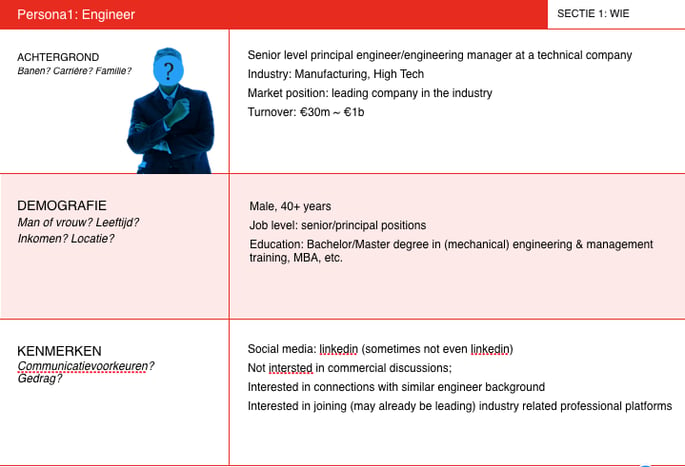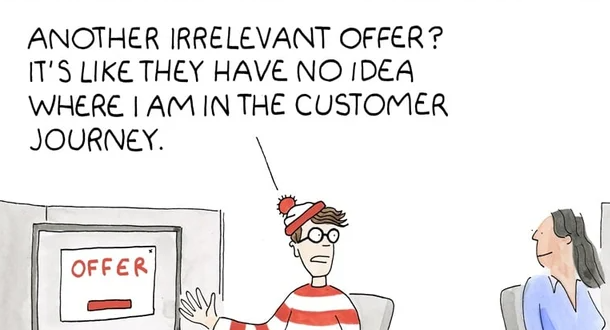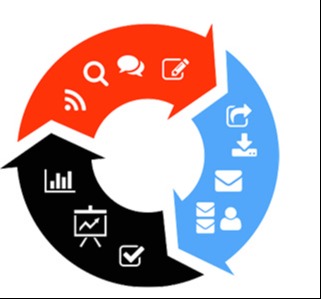Creating buyer persona in 6 steps: for manufacturing companies
As a marketer in the manufacturing industry, it is difficult to generate enough qualified leads. We see that too many manufacturing companies still rely on their reputation, "word of mouth," calls from sales and trade shows to bring in leads and close the sale. However, these methods no longer deliver the results you want in today's digital age.
To generate leads that make sales happy, it's important that marketing activities align with customers' changing wants and needs. The first step you need to take in this regard is to understand your key target audience. What motivates them? What are their main challenges? And what problems do they encounter? You can find this out by creating buyer personas. In this blog I will go through the steps you need to take.
Content
- What are buyer personas?
- Step 1: the background
- Step 2: the function
- Step 3: key goals and pain points
- Step 4: key challenges
- Step 5: information
- Step 6: the objections
What are buyer personas?
Before I take the in-depth look at how to create a buyer persona, let me take a step back. What are buyer personas anyway?
Buyer personas are detailed descriptions of your key customer (groups) based on research. Buyer personas provide insight into the wants, needs, challenges and goals of your target audience, allowing you to deliver your product or service to the right person, in the right place and at the right time in the buyer journey marketing. With buyer personas you develop one integral customer view, allowing marketing and sales to communicate, think and work from the same view.
Step 1: What is the buyer persona's background?
Research into specific (demographic) data about your manufacturing company's key customer (groups) through surveys or interviews helps you gain insight into customers' wants and needs. Where do they live? What is their income? How old are they? What are their communication preferences?
The answers you receive will help you get a realistic picture of key customer (groups).
In this blog, we use Engineer Jim as an example, a buyer persona of manufacturing company Veco. Below you can see how the general data is worked out in an organized way.

Step 2: What is the buyer persona's function?
Detailed information about the function of a customer or prospect is crucial to developing good buyer personas. Understanding the function level, knowledge, goals, responsibilities and experience is essential to creating content that is responsive to their needs and helps them do their job better.
With a sales cycle that can take months to years, knowledge is the biggest driver to gain trust with prospects. In order to know what information your target audience needs, it is not only important to understand the function of the buyer persona.
It is also necessary to know which functions within an organization influence the making of a purchase decision. Who are the decision makers and influencers and what information do they need? For example, is it the engineer who looks for certain information to overcome pain points and the director the one who makes the final decision? These dynamics influence the content you create.
Step 3: What are the key goals and pain points?
Once you understand the facts surrounding the key buyer persona, you can dive deeper into their wants, needs and goals. Find out the target audience's main goals and pain points - what are they stuck with, what are they up against, what do they want to achieve - and know how your products and services help solve these pain points. This allows you to create a consistent message that adds value for your customers and prospects and makes their jobs easier.

Step 4: What are the key challenges?
Your company's main objective should not only be to sell products and services, but also to solve a problem or fulfill a customer need. What challenges does the main customer group face? Is it: innovation? Cost savings? Or process optimization?
By identifying the key challenges, you can publish targeted content that addresses these challenges and provides possible solutions.

Step 5: How does the buyer persona look for information?
Knowing how the potential customer searches for information and how they access it is essential to writing content that is found by the right audience. Do they search in Google? Are they active on social media? If so, are they spending more time on Facebook, Twitter or LinkedIn? Do they read online reviews? Do they read blogs? Knowing this will help you focus on creating and sharing content through the right channels.
Step 6: What are the objections to not buying your product or service?
When you know the objections of your main customer group to not buying a product or service, you can create content that refutes these objections. Moreover, they support the organization to come up with an even better solution to their potential customers' problems.
Buyer personas: a must for a successful digital marketing strategy
Developing buyer personas takes time, but when this step is skipped, your entire digital marketing strategy crumbles. We've seen it happen many times. Many companies are so excited that they start publishing content immediately, without thinking about buyer personas - or the strategy. Or they think creating buyer personas is unimportant. Buyer personas are a must to ensure that your marketing efforts produce enough qualified leads.

Want to stay updated on all HubSpot changes? Subscribe to our newsletters, follow us on Instagram or join our HubSpot User Days!
Explore HubSpot User DaysShare this
You May Also Like
These Related Stories

Creating content strategy for your website: a roadmap

These 14 ways to create fast, great marketing content


